by Douglas R. Clifford and Zachary T. Sampson, Tampa Bay Times | December 12, 2018
Hurricane Michael: Circling Uncertainty
A first-person account of how Tampa Bay Times photographer Douglas Clifford and writer Zachary Sampson documented the aftermath of Hurricane Michael

Tampa Bay Times staff photographer Douglas R. Clifford documents damage in the coastal township of Mexico Beach, Florida, population 1200, which lay devastated on Friday, Oct. 12, 2018. Photo by Zachary T. Sampson, Tampa Bay Times
On a back road in Wewahitchka, we pulled over and reached the short, frustrating conclusion we could no longer avoid. We didn’t know exactly where we were, and we certainly didn’t know where we were going. The neighborhood was pitch black, silent and strange. It felt like defeat. Late on the day that Hurricane Michael hit Florida, we tried for hours to reach Mexico Beach, the small coastal city just east of the storm’s landfall. We identified three possible routes while studying a map under the cabin light of our rented Chevy Tahoe. One way took us through Panama City, also destroyed and filled with reporters. That was out. A second route wound from the north through a heavily timbered stretch that would dump us directly into the landfall zone. It covered about 20 miles; we made it one mile before weary residents passed us in a truck, headed the other way. They said downed trees blocked the road.The last option was scenic U.S. 98, which hugged the shoreline. It seemed foolish to expect the highway had survived the storm. Flooding already blocked the lanes north out of downtown Port St. Joe. We had asked deputies, first south of White City and then in Wewahitchka, how to get to Mexico Beach. Cellphone service was nonexistent, and even their internal radios didn’t work. As far as they knew, they told us, Mexico Beach didn’t exist anymore. Yes, we said. We understood. But we needed to get there.
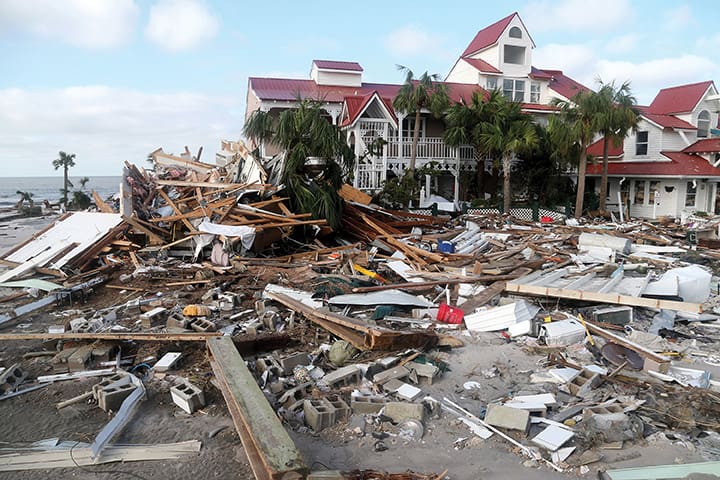
Scattered debris and damage can be seen after Hurricane Michael, a Category 4, slammed into homes in Shell Point Beach on Thursday, Oct. 11, 2018. Photo by Bronte Wittpenn, Tampa Bay Times
The goal is simple but the decisions are tortuous. We’re a team—a writer and photographer—in an SUV, loaded with gear, trying to cover a hurricane as best we can. To do that, we want to reach the disaster zone as soon after the storm as possible. It’s important to share images and descriptions of the area, for people to know what happened—to their homes or relatives or favorite restaurants and vacation places or to a stretch of land that, were it not for some differences in geography or climate or economy, could be their own. Fascination with storm coverage is widespread. We are part of it. The work starts days before, when we try to book a hotel as close to the spot where the hurricane will come ashore as possible, weighing safety against proximity and the unpredictability of a tropical weather system. It continues in the hours after the storm, when we look at each other and make weighty choices: Has the weather eased enough to go outside? Can we drive through the flood? Is that wire live or dead? Of course, we want to be first. National news coverage is competitive, and we feel a special responsibility to share Florida’s story. Sometimes we circle uncertainty, unwilling to accept it, even as the stomach-clench of not knowing overtakes us. We thought about sleeping in our SUV in Wewahitchka, trying to assess the route better in daylight. It was already 9 p.m. or maybe 10—we had been bouncing between Eastern and Central time zones—and adrenaline was dissolving into exhaustion. We tried an old paper mill road through the woods, but it was dirt and blocked by a gate. We tried another route marked on our maps, through high pines. It was dirt too, and a young man in a pickup said we wouldn’t make it far. A deputy earlier had told us of a back road north of downtown Port St. Joe that might cut out the flooding on U.S. 98, but we missed it on a first pass. We decided to try again and drove south once more, pausing at the top of a high bridge over the Intracoastal, where there was limited cell service to call our editors and families to let them know we were okay. The wind was still gusty, and it was too black to see the water or homes below. Beyond the headlights of the truck, even the bridge itself was obscured. The darkness left us with a disoriented feeling, like we were standing in space. The clouds had passed. We could see every star in the sky. We drove until we hit the side road, turning right into a wall of downed trees. It couldn’t be passable. But as we drew close, a zig-zag path revealed itself, carved like a 4-mile zipper through the wreckage.
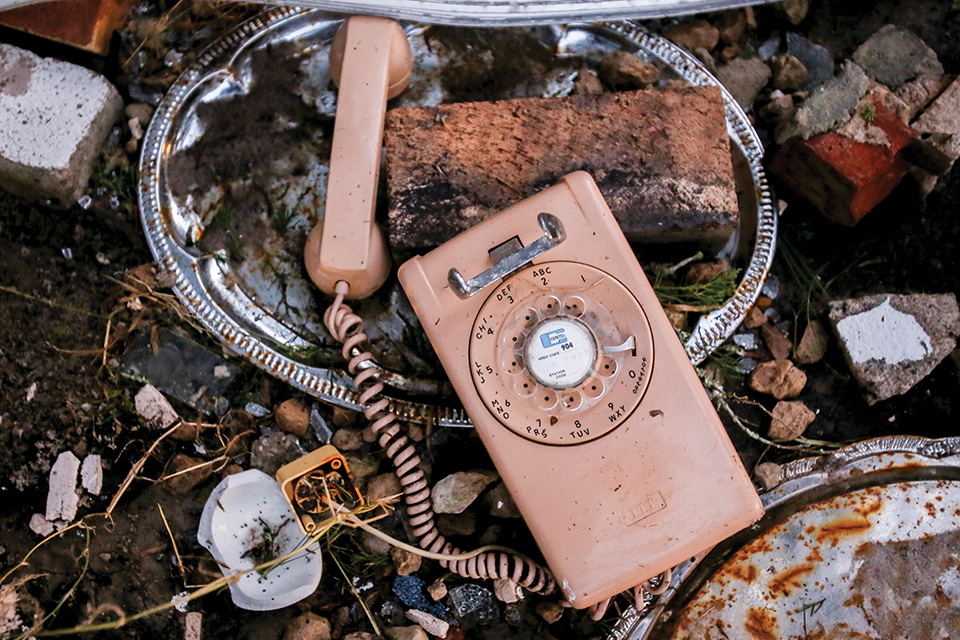
Hurricane Michael made landfall near Mexico Beach on the afternoon of Wednesday, Oct. 10, 2018, devastating the coastal town as it lashed the Florida panhandle. Photo by Bronte Wittpenn, Tampa Bay Times
We’re not sure who made the route, with what tools, or if it was just cyclonic serendipity. But we got through. We turned right onto U.S. 98 and went over another bridge, descending into the western stretches of Port St. Joe, where we began to see downed homes, mangled cars and furniture tossed like flotsam—markers of the apparent edge of Hurricane Michael’s fierce eyewall.
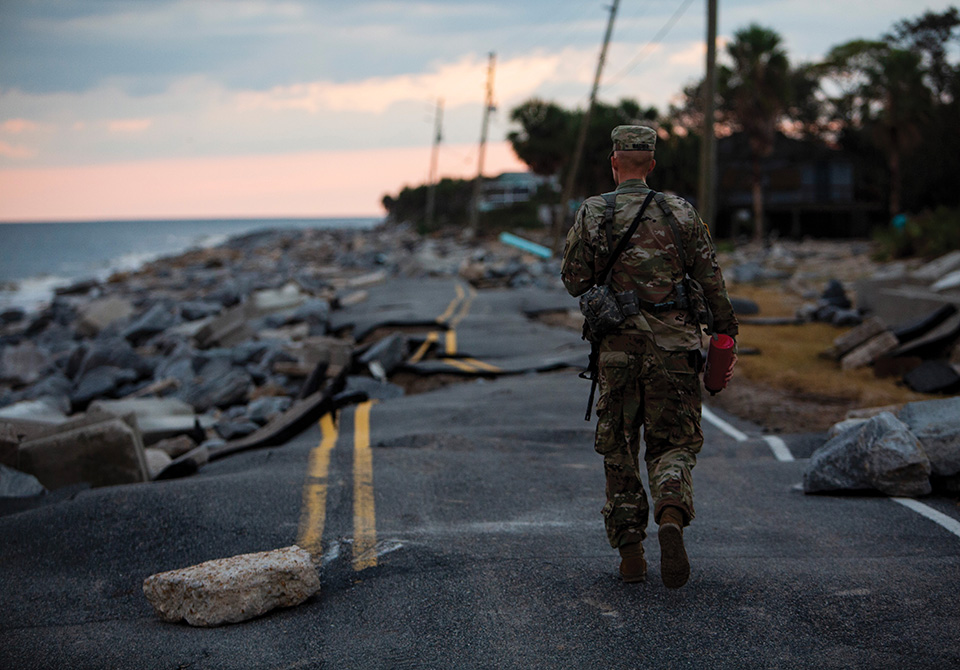
Florida Army National Guard Lt. Matt Wagner walks along what is left of Alligator Drive in Alligator Point, one day after Hurricane Michael hit the area. Photo by Tailyr Irvine, Tampa Bay Times
The plan was to drive until we reached a washout. We still didn’t believe U.S. 98 could have withstood the storm, unbroken, 10 miles to Mexico Beach. But the collapse never came. Parts of the asphalt bordering the sand and Gulf of Mexico were gone. The other lane was fine. It was slow-going, high-beams shining to reveal debris. If we drove too fast we might plummet into a chasm. We stopped frequently, beginning in the neighborhoods southeast of Mexico Beach—Highland View and Beacon Hill—uncertain if we were there yet and already awed by the devastation.We pulled over or negotiated three-point turns on the highway, pointing our headlights to illuminate scenes for photographs. We supplemented with a high-powered flashlight from Walmart. These, we later learned, were the first images many people saw of that area after the storm. A red truck had smashed into a row of apartments where the exterior siding was ripped apart, revealing a line of brightly painted living rooms. Stilt houses, set back from the water, loomed over berms of splintered wood, remnants of neighboring properties. An RV rested on its side, the top wall shorn off, a window into a torn-up interior. And then we reached it. The edge of Mexico Beach, marked with the city’s sign, cracked and thrown back by waves and wind: “Welcome!” it said. “Share the beauty we enjoy everyday!”
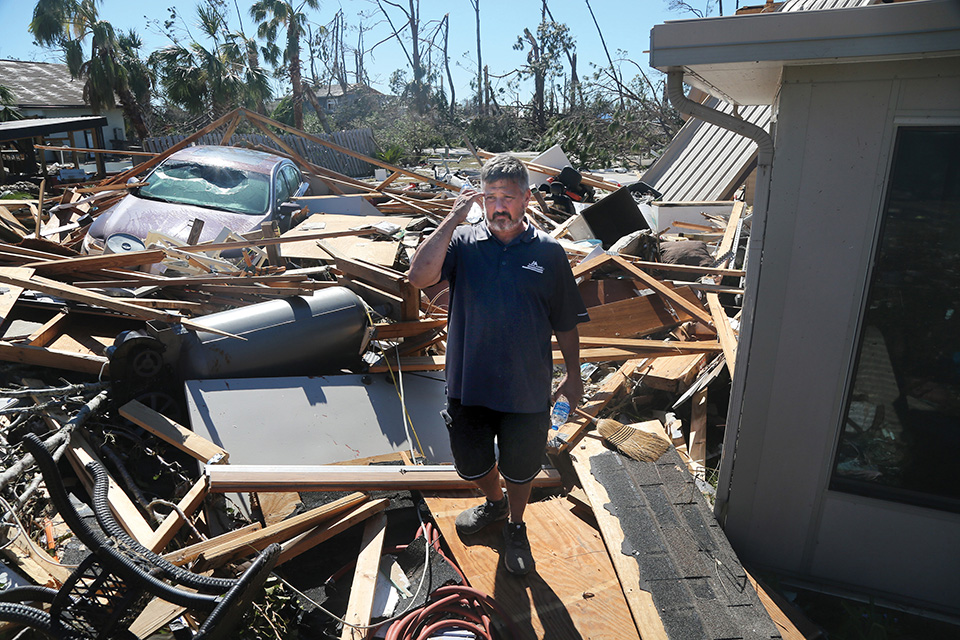
Robert Baker Jr., 51, stands on a pile of building materials which lay piled against the home of his parents. Photo by Douglas R. Clifford, Tampa Bay Times
The seaside town smelled overwhelmingly of natural gas, catching at the back of our nostrils and throats. Soon we smelled smoke. We rolled up to the fire. It smoldered, the building reduced to orange coals like the bottom of a campfire. It was the only brightness. With the windows open, we heard a stereo soundscape of destruction. To the left, waves rumbled as they rolled ashore. To the right, flames sizzled and popped.
We left when we saw what looked like a flashlight blinking down the road. A couple of people were desperate to get a car deep into the wreckage, where an older woman needed a cigarette lighter to power up a machine for her chronic obstructive pulmonary disease. There was no connectivity in Mexico Beach, so to file our work, we had to return to the bridge. That meant risking running into police who might try to block us from the landfall zone for the next few days. We decided the story was too important to wait, and we hurried back to transmit.
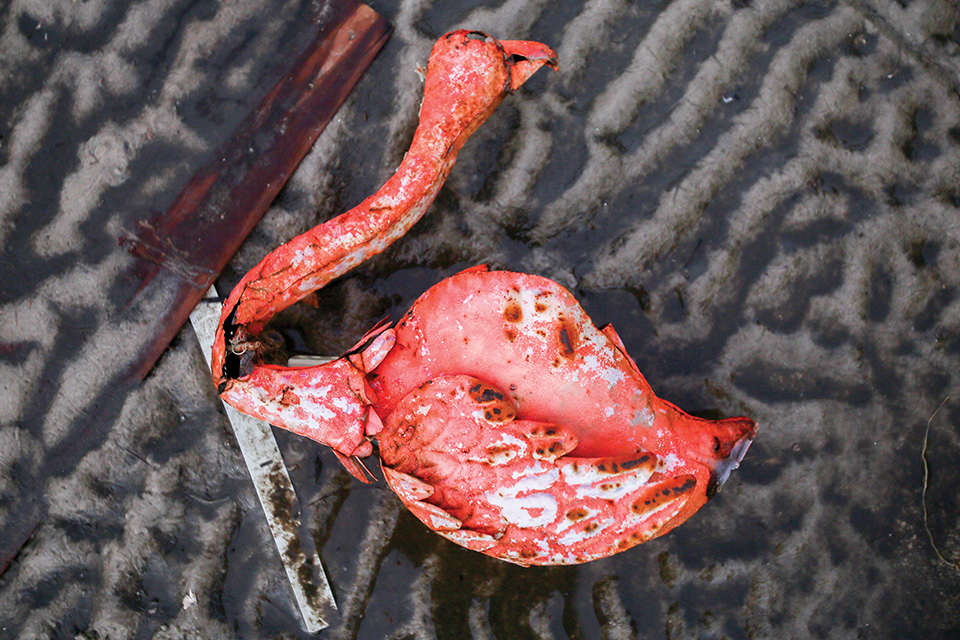
Scattered debris and damage can be seen after Hurricane Michael, a Category 4, slammed into homes in Shell Point Beach. Photo by Bronte Wittpenn, Tampa Bay Times
After roughly 20 minutes atop the bridge, about 1 a.m., we sent all of our work. It comprised a handful of tweets and several photo galleries. We turned back and—seeing no deputies—drove again to Mexico Beach, parking behind a heavily damaged home, slightly up a small hill. Just below, a truck lay with two Mazda Miatas amid a mess of two-by-fours.
We reclined our seats and went to sleep. At sunrise, with the Gulf of Mexico just across the street, a backdrop to ruin, we awoke to see the owners of those vehicles surveying the damage and looking to light a cigarette. They were the first people we spoke to, learning of their harrowing flight as the dark water surged across the road. We offered them coffee, boiled with a camp burner, and drove deeper into Mexico Beach.
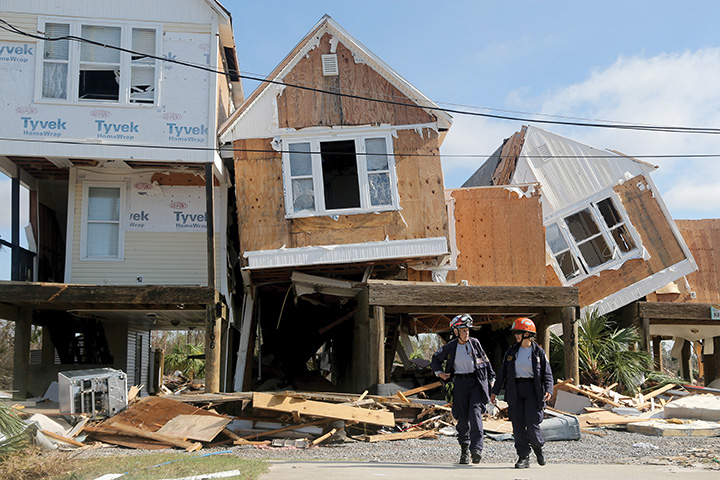
Emergency workers Dr. Patricia Cantrell, left, and Ana Kaufmann, with the South Florida Search and Rescue Task Force 2, survey damage at the western edge of town at Mexico Beach. Photo by Douglas R. Clifford, Tampa Bay Times
The northwestern part of the city was most heavily damaged. The mayor’s wife didn’t want to be quoted, but she pointed us to a side street that allowed us to get there, dodging an impassable stretch of U.S. 98. We reported over the course of two days in Mexico Beach. The damage in stark daylight was even more extensive than we imagined at night. Soon the bureaucracy of destruction set in, with federal officials and local authorities restricting access to the landfall zone.
Just before we left, we pulled close to the water, in a leveled neighborhood we had not yet visited. There were no residents left. There wasn’t much of anything.
Walking around the slabs, we looked down to see unbroken bottles of beer and an intact tile floor. We seemed to be in someone’s kitchen, blocks from the beach in what used to be a pleasant retreat, “The Mayberry of the Coast.”
We hiked to one house, sturdy and upright, and climbed over some wires to ascend the stairs to a second-floor deck. The view was a panorama of catastrophe, shards of paradise everywhere we looked.

Rescue workers use a cadaver dog to search the coastal township of Mexico Beach, population 1,200, which lay devastated. Photo by Douglas R. Clifford, Tampa Bay Times
We hopped back in the SUV to file another story, with more photographs and more video. As we drove out, search teams combed the wreckage with dogs, looking for survivors or the dead.
We left Mexico Beach, for now, uneasy but grateful that we could drive away from disaster, a privilege that also carries shame.
The people of another Florida community are left behind to sort through fractured lives, while others watch, knowing a different storm, at a different time, might spin their way.
This article first appeared online on Tampabay.com on 10/18/18





